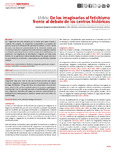
Please use this identifier to cite or link to this item:
http://ricaxcan.uaz.edu.mx/jspui/handle/20.500.11845/494Full metadata record
| DC Field | Value | Language |
|---|---|---|
| dc.contributor | 90730 | es_ES |
| dc.coverage.spatial | Global | es_ES |
| dc.creator | González Hernández, Guadalupe Margarita | - |
| dc.date.accessioned | 2018-02-28T18:31:42Z | - |
| dc.date.available | 2018-02-28T18:31:42Z | - |
| dc.date.issued | 2013-04-28 | - |
| dc.identifier | info:eu-repo/semantics/publishedVersion | es_ES |
| dc.identifier.issn | e-ISSN: 2215-9312 | es_ES |
| dc.identifier.uri | http://hdl.handle.net/20.500.11845/494 | - |
| dc.description | Imaginaries have seen used by the city to attract tourists and capital. However, imaginaries correspond to analysis of social process of cultural heritage fetishization. Things and ideas are autonomized of social rela-tions, which in the current capitalist system of economic organization, involving their use for opening new areas of profitability and capitaliza-tion. Imaginaries, identities and images are useful as cultural fetishes es-tablished by dominant groups to introduce market and to sell urban cul-tural heritage. | es_ES |
| dc.description.abstract | Los imaginarios han sido utilizados por la ciudad para atraer turistas y capitales. No obstante, los imaginarios corresponden a un análisis del proceso social de fetichización del patrimonio cultural; es decir, donde las cosas y las ideas son autonomizados de las relaciones sociales, que en el actual sistema de organización socioeconómica capitalista implican su utilización para la apertura de nuevos campos de rentabilización y ca-pitalización. Los imaginarios, las identidades e imágenes son útiles como fetiches de un patrimonio cultural establecido por los grupos dominan-tes para introducir al mercado y comercializar los patrimonios culturales urbanos | es_ES |
| dc.language.iso | spa | es_ES |
| dc.publisher | Sapiens Research Group | es_ES |
| dc.relation | http://www.sapiensresearch.org/images/pdf/v3n2/V3N2_Urbis_1.pdf | es_ES |
| dc.relation.ispartof | http://www.srg.com.co/bcsr/index.php/BCSR | es_ES |
| dc.relation.uri | generalPublic | es_ES |
| dc.rights | Attribution-NonCommercial-ShareAlike 3.0 United States | * |
| dc.rights.uri | http://creativecommons.org/licenses/by-nc-sa/3.0/us/ | * |
| dc.source | Boletín Científico Sapiens Research | es_ES |
| dc.subject.classification | CIENCIAS SOCIALES [5] | es_ES |
| dc.subject.other | Centros históricos | es_ES |
| dc.subject.other | Fetichismo | es_ES |
| dc.subject.other | Imaginarios | es_ES |
| dc.subject.other | Patrimonio y turismo | es_ES |
| dc.subject.other | Historic centre | es_ES |
| dc.subject.other | Fetishism | es_ES |
| dc.subject.other | Heritage and tourism | es_ES |
| dc.title | Urbis: De los imaginarios al fetichismo frente al debate de los centros históricos | es_ES |
| dc.title.alternative | From imaginaries to fetishism from a discussion historic centers | es_ES |
| dc.type | info:eu-repo/semantics/article | es_ES |
| Appears in Collections: | *Documentos Académicos*-- UA Estudios del Desarrollo | |
Files in This Item:
| File | Description | Size | Format | |
|---|---|---|---|---|
| González Hernández Urbis.pdf | 425,18 kB | Adobe PDF |  View/Open |
This item is licensed under a Creative Commons License
